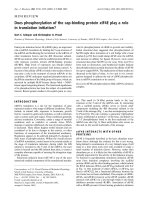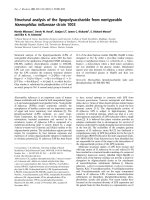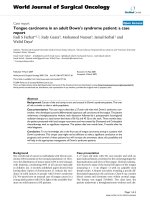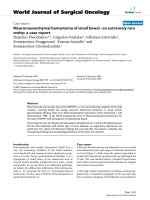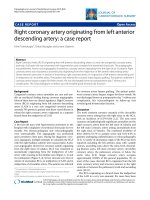Báo cáo y học: " Anaplastic carcinoma of the pancreas producing granulocyte-colony stimulating factor: a case report" potx
Bạn đang xem bản rút gọn của tài liệu. Xem và tải ngay bản đầy đủ của tài liệu tại đây (967.32 KB, 4 trang )
BioMed Central
Page 1 of 4
(page number not for citation purposes)
Journal of Medical Case Reports
Open Access
Case report
Anaplastic carcinoma of the pancreas producing
granulocyte-colony stimulating factor: a case report
Atsushi Nakajima
1
, Hirokazu Takahashi
1
, Masahiko Inamori*
1
,
Yasunobu Abe
1
, Noritoshi Kobayashi
1
, Kensuke Kubota
1
and
Shoji Yamanaka
2
Address:
1
Gastroenterology Division, Yokohama City University Hospital, 3-9 Fukuura, Kanazawa-ku Yokohama 236-0004, Japan and
2
Division
of Pathology, Yokohama City University Hospital, Yokohama, Japan
Email: Atsushi Nakajima - ; Hirokazu Takahashi - ;
Masahiko Inamori* - ; Yasunobu Abe - ;
Noritoshi Kobayashi - ; Kensuke Kubota - ; Shoji Yamanaka -
* Corresponding author
Abstract
Introduction: The granulocyte-colony stimulating factor-producing tumor was first reported in
1977, however, anaplastic pleomorphic type carcinoma of the pancreas producing granulocyte-
colony stimulating factor is still rare.
Case presentation: A 63-year-old man was admitted to our hospital with body weight loss (-10
kg during months) and upper abdominal pain from 3 weeks. Abdominal computed tomography
demonstrated a pancreatic tumor 10 cm in size and multiple low-density areas in the liver. On
admission, the peripheral leukocyte count was elevated to 91,500/mm
3
and the serum
concentration of granulocyte-colony stimulating factor was 134 pg/mL (normal, < 18.1 pg/mL).
Based on liver biopsy findings, the tumor was classified as an anaplastic pleomorphic-type
carcinoma. Immunohistochemical staining showed that pancreatic carcinoma cells were positive for
granulocyte-colony stimulating factor. The patient developed interstitial pneumonia, probably
caused by granulocyte-colony stimulating factor, and died 11 days after admission.
Conclusion: This is a rare case report of anaplastic pleomorphic-type carcinoma of the pancreas
producing granulocyte-colony stimulating factor and confirmed by immunohistochemistry.
Introduction
The granulocyte-colony stimulating factor (G-CSF)-pro-
ducing tumor was first reported in 1977 by Asano et al. in
lung cancer [1]. Since that study, further G-CSF-producing
lung carcinomas have been reported, but G-CSF-produc-
ing pancreatic carcinomas have been very rare [2-7].
Moreover, there have been only a few cases which have
reported positive immunostaining for G-CSF in cancer
cells [6,7]. We present a case of an anaplastic pancreatic
carcinoma with G-CSF production that was confirmed
with immunohistochemistry.
Case presentation
A 63-year-old man was admitted to our hospital with
body weight loss (-10 kg during 6 months) and upper
abdominal pain. His blood pressure was 123/71 mmHg,
Published: 17 December 2008
Journal of Medical Case Reports 2008, 2:391 doi:10.1186/1752-1947-2-391
Received: 30 January 2008
Accepted: 17 December 2008
This article is available from: />© 2008 Nakajima et al; licensee BioMed Central Ltd.
This is an Open Access article distributed under the terms of the Creative Commons Attribution License ( />),
which permits unrestricted use, distribution, and reproduction in any medium, provided the original work is properly cited.
Journal of Medical Case Reports 2008, 2:391 />Page 2 of 4
(page number not for citation purposes)
pulse was 92 bpm. Physical examination revealed upper
left quadrant pain but soft in his abdomen. The tumor
was palpable in the upper left abdomen.
Laboratory examination findings were as follows: Periph-
eral leukocyte count was 91,500/mm
3
(87.5% neu-
trophils, 0% eosinophils, 1.5% lymphocytes, 1%
monocytes), hemoglobin was 10.3 g/dL, and platelet
count was 38.3 × 10
4
/mm
3
. Serum pancreatic enzymes
such as amylase, lipase, and elastase-1 were normal.
Serum tumor markers such as sIL-2R (soluble interleukin-
2 receptor) and TK (thymidine kinase) were elevated to
2870 U/ml and 15 U/L, respectively, but CEA (Carci-
noembryonic Antigen), CA 19-9 (Carbohydrate Antigen
19-9) and NSE (Neuron-specific enolase) were normal.
The serum G-CSF was elevated to 134 pg/mL (normal, <
18.1 pg/mL, by enzyme immunoassay).
Computed tomography (CT) showed a heterogeneously
enhanced mass 10 cm in diameter in the left upper abdo-
men and multiple low density areas in the liver (see Figure
1). The pancreas could not be detected and it is suggested
that the large tumor was originally derived from the pan-
creas. Magnetic resonance imaging showed a mass of het-
erogeneous intensity on both T1- and T2-weighted
images. Endoscopic examination revealed an extrinsic
compression 10 cm in size, at the lesser curve of the body
of the stomach. In 2-deoxy-2-[18F]-fluoro-D-glucose pos-
itron emission tomography (PET), the maximum stand-
ardized uptake value was over 11 at his left upper
abdominal lesion. No source of infection was detected.
We therefore speculated that this case might be a G-CSF-
producing pancreatic carcinoma.
Following informed consent, a tumor biopsy of the liver
was performed. Histopathologic diagnosis of the tumor
was an anaplastic pleomorphic-type carcinoma (see Fig-
ure 2). Immunohistochemical staining of formalin-fixed
paraffin-embedded liver biopsy material was performed.
The pancreatic cancer cells were positive for G-CSF (see
Figure 3).
The patient developed interstitial pneumonia, probably
caused by G-CSF produced by the carcinoma, and died 11
days after admission.
Discussion
In 1977, Asano et al. [1] reported a case of G-CSF-produc-
ing lung cancer. Since then, G-CSF-producing tumors
have been reported, however, most cases were of lung can-
cer origin and G-CSF-producing pancreatic cancer is very
rare [2-7].
In the present case, the peripheral leukocyte count was
markedly elevated (91,500/mm
3
) on admission, how-
ever, no source of infection was detected. Serum G-CSF
was elevated to 134 pg/mL. In the liver biopsy material,
the histology was anaplastic pleomorphic-type carcinoma
and G-CSF was positive on immunohistochemical stain-
ing, so we considered that this tumor produced G-CSF. It
is uncommon for G-CSF production to be successfully
demonstrated with immunohistochemical staining
[4,6,7].
Anaplastic carcinoma of the pancreas, also called undiffer-
entiated carcinoma, giant cell carcinoma, pleomorphic
large cell carcinoma or sarcomatoid carcinoma, is not
common. The incidence of the tumor is only about 2% to
7% of all pancreatic cancers [8-11]. Anaplastic carcinoma
Computed tomography showed an unevenly enhanced mass 10 cm in diameter in the patient's left upper abdomenFigure 1
Computed tomography showed an unevenly enhanced mass
10 cm in diameter in the patient's left upper abdomen.
Histopathologic diagnosis of the tumor was an anaplastic ple-omorphic-type carcinoma (hematoxylin and eosin stain; ×100)Figure 2
Histopathologic diagnosis of the tumor was an anaplastic ple-
omorphic-type carcinoma (hematoxylin and eosin stain;
×100).
Journal of Medical Case Reports 2008, 2:391 />Page 3 of 4
(page number not for citation purposes)
has also been rarely identified as a G-CSF-producing
tumor [5].
G-CSF-producing tumors are considered to indicate a
poor prognosis [2]. In G-CSF-producing lung cancer, large
cell tumors and squamous cell tumors are dominant [2].
The 5-year survival rate of large cell tumors is only 14.0%
[12]. In addition, Uematsu et al. [3] reported that histo-
logic examination of G-CSF-producing carcinomas usu-
ally reveals poorly differentiated cells, and moreover, the
tumors exhibit rapid growth and are associated with a
poor prognosis.
The prognosis of G-CSF-producing carcinomas of the pan-
creas is also poor. Ohtsubo et al., Kawakami et al., Goto-
hda et al., Fukushima et al., and our case showed that the
survival from tumor detection to death ranged from 11 to
135 days, with a mean of 81.2 days [4-7].
The patient developed interstitial pneumonia and died 11
days after admission. Why did interstitial pneumonia
develop? Cases of interstitial pneumonia secondary to
treatment with G-CSF have been reported [13]. G-CSF
stimulates neutrophils and macrophages. Cytotoxic
superoxide from neutrophils and various growth factors
from macrophages cause interstitial pneumonia [13]. An
increased serum G-CSF level and interstitial pneumonia
may be reasons for poor prognosis in patients with G-CSF-
producing tumors as in our case.
Conclusion
This is a rare case report of an anaplastic pleomorphic-
type carcinoma of the pancreas producing granulocyte-
colony stimulating factor, and confirmed with immuno-
histochemistry. The clinical characteristics of this disease
are still unclear and further detailed studies should be per-
formed.
Abbreviations
CA19-9: Carbohydrate Antigen 19-9; CEA: Carcinoembry-
onic Antigen; CT: computed tomography; G-CSF: granu-
locyte-colony stimulating factor; NSE: Neuron-specific
enolase; PET: Positron Emission Tomography; sIL-2R:
(soluble interleukin-2 receptor); TK: (thymidine kinase)
Consent
Written informed consent was obtained from the patient
for publication of this case report and any accompanying
images. A copy of the written consent is available for
review by the Editor-in-Chief of this journal.
Competing interests
The authors declare that they have no competing interests.
Authors' contributions
AN: study concept and design, patient care, drafting the
manuscript, HT: study concept and design, patient care,
drafting the manuscript, MI: study concept and design,
patient care, data analysis, literature review, drafting and
revising the manuscript, YA: study concept and design,
patient care, drafting the manuscript, NK: study concept
and design, patient care, drafting the manuscript, litera-
ture review, KK: study concept and design, patient care,
drafting the manuscript, SY: study concept and design,
patient care, drafting the manuscript, literature review. All
authors have read and approved the final version of the
manuscript.
Acknowledgements
No funding was required for this study.
References
1. Asano S, Urabe A, Okabe T, Sato N, Kondo Y: Demonstration of
granulopoietic factor(s) in the plasma of nude mice trans-
planted with a human lung cancer and in the tumor tissue.
Blood 1977, 49(5):845-852.
2. Ohwada S, Miyamoto Y, Fujii T, Kuribara T, Teshigawara O, Oyama
T, Ishii H, Joshita T, Izuo M: Colony stimulating factor producing
carcinoma of the pancreas – a case report. Gan No Rinsho 1989,
35(4):523-527.
3. Uematsu T, Tsuchie K, Ukai K, Kimoto E, Funakawa T, Mizuno R:
Granulocyte-colony stimulating factor produced by pancre-
atic carcinoma. Int J Pancreatol 1996, 19(2):135-139.
4. Kawakami H, Kuwatani M, Fujiya Y, Uebayashi M, Konishi K, Maki-
yama H, Hashino S, Kubota K, Itoh T, Asaka M: A case of granulo-
cyte-colony stimulating factor producing ductal
adenocarcinoma of the pancreas. Nippon Shokakibyo Gakkai
Zasshi 2007, 104(2):233-238.
5. Gotohda N, Nakagohri T, Saito N, Ono M, Sugito M, Ito M, Inoue K,
Oda T, Takahashi S, Kinoshita T: A case of anaplastic ductal car-
cinoma of the pancreas with production of granulocyte-col-
ony stimulating factor. Hepatogastroenterology 2006,
53(72):957-959.
6. Fukushima N, Sasatomi E, Tokunaga O, Miyahara M: A case of pan-
creatic cancer with production of granulocyte colony-stimu-
lating factor. Am J Gastroenterol 2001, 96(1):258-259.
Immunohistochemical staining of formalin-fixed paraffin-embedded liver biopsy material was performedFigure 3
Immunohistochemical staining of formalin-fixed paraffin-
embedded liver biopsy material was performed. The pancre-
atic cancer cells were positive for granulocyte-colony stimu-
lating factor (×40).
Publish with BioMed Central and every
scientist can read your work free of charge
"BioMed Central will be the most significant development for
disseminating the results of biomedical research in our lifetime."
Sir Paul Nurse, Cancer Research UK
Your research papers will be:
available free of charge to the entire biomedical community
peer reviewed and published immediately upon acceptance
cited in PubMed and archived on PubMed Central
yours — you keep the copyright
Submit your manuscript here:
/>BioMedcentral
Journal of Medical Case Reports 2008, 2:391 />Page 4 of 4
(page number not for citation purposes)
7. Ohtsubo K, Mouri H, Sakai J, Akasofu M, Yamaguchi Y, Watanabe H,
Gabata T, Motoo Y, Okai T, Sawabu N: Pancreatic cancer associ-
ated with granulocyte-colony stimulating factor production
confirmed by immunohistochemistry. J Clin Gastroenterol 1998,
27(4):357-360.
8. Wong M, See JY, Sufyan W, Diddapur RK: Splenic infarction. A
rare presentation of anaplastic pancreatic carcinoma and a
review of the literature. JOP 2008, 9(4):493-498.
9. Benedix F, Schmidt C, Schulz HU, Lippert H, Meyer F, Pech M: Con-
tinuous intra-arterial chemotherapy with 5-fluorouracil and
cisplatin for locally advanced anaplastic carcinoma of the
pancreas. Int J Colorectal Dis 2008, 23(7):729-731.
10. Paal E, Thompson LD, Frommelt RA, Przygodzki RM, Heffess CS: A
clinicopathologic and immunohistochemical study of 35 ana-
plastic carcinomas of the pancreas with a review of the liter-
ature. Ann Diagn Pathol 2001, 5(3):129-140.
11. Chadha MK, LeVea C, Javle M, Kuvshinoff B, Vijaykumar R, Iyer R:
Anaplastic pancreatic carcinoma. A case report and review
of literature. JOP 2004, 5(6):512-515.
12. Morita Y, Yamagishi M, Shijubo N, Takezawa C, Hirao M, Kurokawa
K, Honma A, Asakawa M, Suzuki A: Granulocyte colony-stimulat-
ing factor producing lung large cell carcinoma with sarcoma-
tous transformation. Nihon Kyobu Shikkan Gakkai Zasshi 1992,
30(8):1548-1553.
13. Niitsu N, Iki S, Muroi K, Motomura S, Murakami M, Takeyama H,
Ohsaka A, Urabe A: Interstitial pneumonia in patients receiv-
ing granulocyte colony-stimulating factor during chemo-
therapy: survey in Japan 1991–96. Br J Cancer 1997,
76(12):1661-1666.

